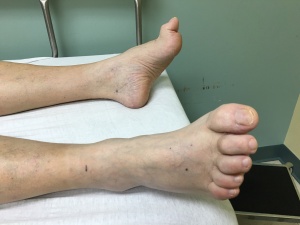Hammer toes
From Neurosigns
Hammer toes are a deformity of one or more of the lesser four toes that creates flexion of the PIP joint (Figure 1). The PIP deformity may be fixed or supple. With some hammer toes the MTP joint is hyperextended. DIP joint involvement is variable. The terms claw toe and hammer toe are sometimes used synonymously.(1) Hammer toes are frequently associated with denervating conditions that cause weakness of the intrinsic foot muscles. This patient had Charcot-Marie-Tooth disease. An imbalance results between the extrinsic extensor tendons that extend the MTP joints and the intrinsics that flex them, resulting in the toe deformity. Atrophy of the foot with guttering of the dorsum and prominence of the tendons is commonly present as well. Hammer toes may also develop for a number of nonneurologic reasons.
References
1. Schrier, JC, Verheyen, CC, and Louwerens, JW. Definitions of hammer toe and claw toe: an evaluation of the literature. J Am Podiatr Med Assoc. 2009; 99:194-197.
